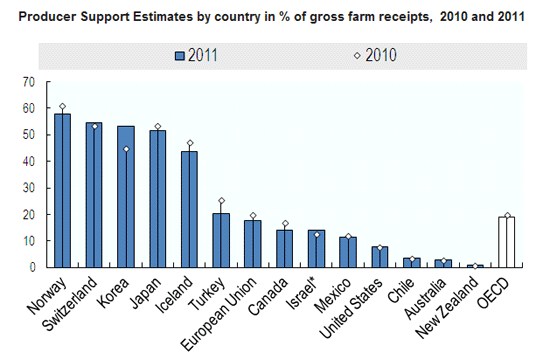
Government support of agriculture in OECD countries fell to 19% of total farm receipts in 2011, a record low driven by developments in international commodity markets, rather than by explicit policy changes, according to the latest version of an annual OECD report.
Support to producers stood at US$252 billion (NZ$315 billion) in OECD countries in 2011, confirming a longstanding trend toward falling farm support.
While Agricultural Policy: Monitoring and Evaluation 2012 points to a generalised move away from support directly linked to production, it finds that support which distorts production and trade still represents about half of the total.
“The move toward lower farm support is a welcome trend, but we still see the need for better targeting and more cost-effective farm policy,” said OECD Trade and Agriculture Director Ken Ash. ”Farm support should be more closely directed at increasing agricultural productivity and competitiveness. Governments should also be doing more to address environmental issues, ensure sustainable resource use and help farmers better cope with risk.”
The new report shows that support levels still vary widely across OECD countries.
Over the 2009-11 period, New Zealand had the lowest level of support, at just 1% of farm income, followed by Australia (3%), and Chile (4%).
Almost all the New Zealand 'support' relates to 'agricultural research and biosecurity controls for pests and diseases' that is not funded by the industry. (p190)
The Irrigation Accelration Fund, the Sustainable farming Fund and the Primary Growth Partnership all also get a mention in this Report as examples of New Zealand's 'government support to agriculture'.
The United States (9%), Mexico (12%), Israel (13%) and Canada (16%) were also below the OECD average (20%).
At the other end of the scale, support to farmers remains high in the EU at 20% of farm income, Iceland (47%), Korea (50%), Japan (51%), Switzerland (56%) and Norway (60%).

The report also shows that total support to agriculture as a percentage of national income is falling in the OECD area, declining from 3% of GDP on average over the 1986-88 period to less than 1% in 2009-11.
This declining trend is observed in all OECD countries over the long term.
The OECD projects that today’s relatively high commodity prices will continue over the medium-term outlook, meaning that markets will provide farmers the income that many governments have until now sought to provide through cash payments or artificially high prices.





We welcome your comments below. If you are not already registered, please register to comment.
Remember we welcome robust, respectful and insightful debate. We don't welcome abusive or defamatory comments and will de-register those repeatedly making such comments. Our current comment policy is here.